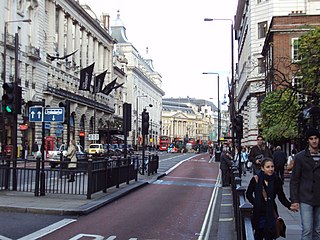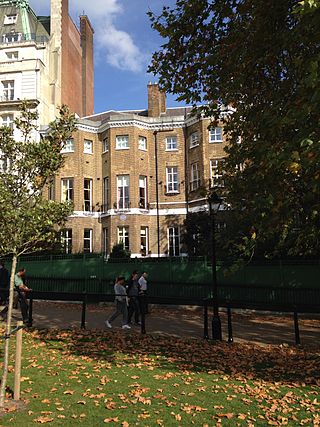
Apsley House is the London townhouse of the Dukes of Wellington. It stands alone at Hyde Park Corner, on the south-east corner of Hyde Park, facing towards the large traffic roundabout in the centre of which stands the Wellington Arch. It is a Grade I listed building.

Piccadilly is a road in the City of Westminster, London, England, to the south of Mayfair, between Hyde Park Corner in the west and Piccadilly Circus in the east. It is part of the A4 road that connects central London to Hammersmith, Earl's Court, Heathrow Airport and the M4 motorway westward. St James's is to the south of the eastern section, while the western section is built up only on the northern side. Piccadilly is just under 1 mile (1.6 km) in length, and it is one of the widest and straightest streets in central London.

An apartment, flat, or unit is a self-contained housing unit that occupies part of a building, generally on a single story. There are many names for these overall buildings. The housing tenure of apartments also varies considerably, from large-scale public housing, to owner occupancy within what is legally a condominium or leasehold, to tenants renting from a private landlord.

The Ritz London is a 5-star luxury hotel at 150 Piccadilly in London, England. A symbol of high society and luxury, the hotel is one of the world's most prestigious and best known. The Ritz has become so associated with luxury and elegance that the word "ritzy" has entered the English language to denote something that is ostentatiously stylish, fancy, or fashionable.

This article describes the hotels in London, England.

Benjamin Dean Wyatt (1775–1852) was an English architect, part of the Wyatt family.

Dover Street is a street in Mayfair, London. The street is notable for its Georgian architecture as well as the location of historic London clubs and hotels, which have been frequented by world leaders and historic figures in the arts. It also hosts a number of contemporary art galleries. An equestrian sculpture by Elisabeth Frink stands on the junction of Dover Street and Piccadilly, opposite the Ritz Hotel.

Multifamily residential, also known as multidwelling unit (MDU), is a classification of housing where multiple separate housing units for residential inhabitants are contained within one building or several buildings within one complex. Units can be next to each other, or stacked on top of each other. Common forms include apartment building and condominium, where typically the units are owned individually rather than leased from a single building owner. Many intentional communities incorporate multifamily residences, such as in cohousing projects.

The Wolseley is a restaurant located at 160 Piccadilly in London, England, next to The Ritz London. Designed by the architect William Curtis Green, the Grade II* listed building was erected by Wolseley Motors in 1921 as their regional offices with a ground floor showroom. The ground floor was occupied by a branch of Barclays Bank between 1927 and 1999. After a brief period as a Chinese restaurant, it reopened in 2003 as the Wolseley following extensive renovations by British restaurateurs Chris Corbin and Jeremy King.

Basildon Park is a country house situated 2 miles south of Goring-on-Thames and Streatley in Berkshire, between the villages of Upper Basildon and Lower Basildon. It is owned by the National Trust and is a Grade I listed building. The house was built between 1776 and 1783 for Sir Francis Sykes and designed by John Carr in the Palladian style at a time when Palladianism was giving way to the newly fashionable neoclassicism. Thus, the interiors are in a neoclassical "Adamesque" style.

The St. Pancras Renaissance London Hotel forms the frontispiece of St Pancras railway station in St Pancras, London. The station is one of the main rail termini in London and the final stop for international trains departing to Paris, Brussels, Amsterdam and other destinations in mainland Europe. It re-opened in 2011, and occupies much of the former Midland Grand Hotel designed by George Gilbert Scott which opened in 1873 and closed in 1935. The hotel is managed by Marriott International.

The Carlton Hotel was a luxury hotel in London that operated from 1899 to 1940. It was designed by the architect C. J. Phipps as part of a larger development that included the rebuilding of Her Majesty's Theatre, which is adjacent to the hotel site. The Carlton was originally run by the Swiss hotelier César Ritz, with Auguste Escoffier as the head chef. In its early days it was one of London's most fashionable hotels and drew some customers away from the Savoy Hotel, which Ritz and Escoffier had previously managed.

The Regent Palace Hotel was a large hotel in central London at 10 Glasshouse Street, close to Piccadilly Circus, between 1915 and 2006. It was designated as a Grade II listed building by English Heritage in 2004.

In British usage, the term townhouse originally referred to the opulent town or city residence of a member of the nobility or gentry, as opposed to their country seat, generally known as a country house or, colloquially, for the larger ones, stately home. The grandest of the London townhouses were stand-alone buildings, but many were terraced buildings.
Bath House in Piccadilly was the London residence of the Barons Ashburton in the 19th century. Formerly the site of the Pulteney Hotel, the property was acquired by Mr. Alexander Baring from William Pulteney, 1st Earl of Bath in 1821 and rebuilt and renamed after the Earl.

Wimbourne House is a historic townhouse at 22 Arlington Street in St James's, a district of the City of Westminster in central London, England. Designed in the Neo-Palladian style by William Kent, it was built between 1743 and 1754, being completed after the architect's death. It is a Grade II* listed building, and the west front overlooks Green Park. The building now houses special event rooms for the adjacent Ritz Hotel.

Tower House is a former private house in the Withdean area of the English coastal city of Brighton and Hove. Built in 1902 for a former jeweller to King Edward VII, it remained in private ownership until it was converted into flats and a daycare centre in 1988. It is one of the few large houses and villas to survive in the high-class Withdean area—many were demolished in favour of blocks of flats after World War II—and it has been described as "Brighton's finest example of a grand Edwardian house". English Heritage has listed the building at Grade II for its architectural and historical importance.

The Old White Horse Cellar at No. 155 Piccadilly was one of the best-known coaching inns in England during the 18th and 19th centuries. The first mention of the White Horse Cellar is in 1720. It was originally located on the corner of Arlington Street, where the Ritz Hotel is now located. The first landlord, a man named Williams, named it in honor of the newly established House of Hanover, whose heraldic emblem featured a white horse. The White Horse rose to prominence under Abraham Hatchett who later moved it to the opposite side of the road on the corner of Albemarle Street, where it was known as "Hatchett’s Hotel and White Horse Cellar". The precise date of the move is not known, but was precipitated by the construction of the Bath Hotel, which was located on the corner of Piccadilly and Arlington as early as 1798. It was torn down in 1884 to make room for the Albemarle.
The Bath Hotel was located at 155 Piccadilly on the site of what is now The Ritz Hotel, London and was adjacent to the Walsingham House. The Ritz' financial backers began negotiations in 1901 and purchased the Bath in 1902 simultaneously with the acquisition of the Walsingham. One of the considerations that made the transaction appealing to the city was that they would be able to widen Piccadilly when the Walsingham and Bath Hotels were demolished.

Piccadilly is a street in the city centre of York, in England.




















